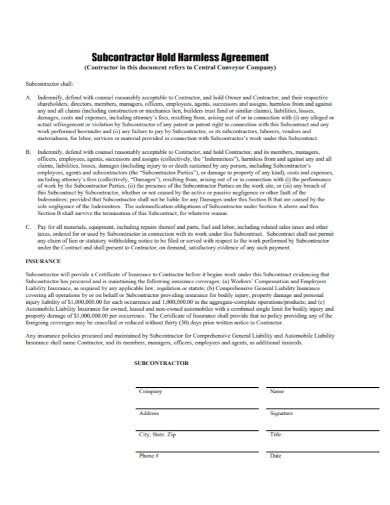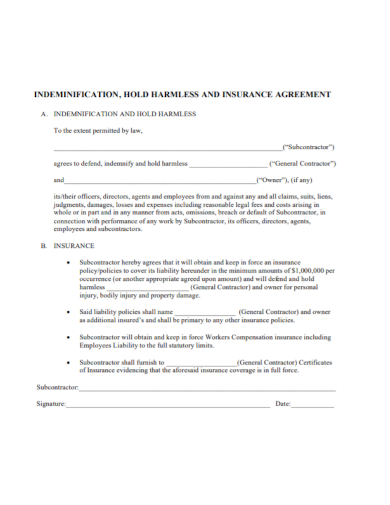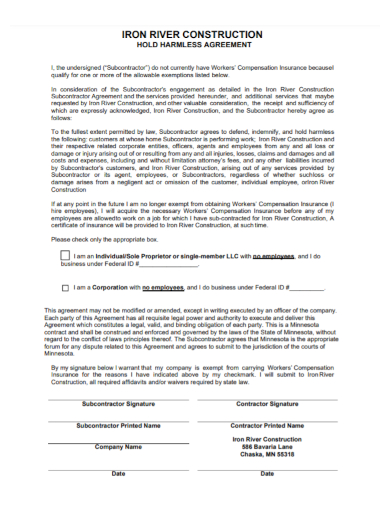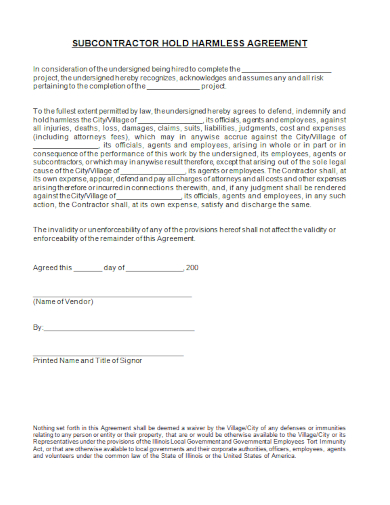Using contracts to protect your financial and legal rights when hiring a subcontractor can be extremely beneficial. In the construction industry, hiring subcontractors to do a portion of someone else’s work is a common practice. For example, a graphic designer might hire a writer to write the text for a brochure he or she is creating for a client. Subcontracting can be done in almost any type of business or profession. A contract can be used to explain and clarify all of the terms and conditions of your agreement, including the scope of the assignment, deadlines, and payment arrangements, to name a few.
A subcontractor agreement may appear to be a way for contractors to protect themselves rather than subcontractors; however, subcontractors may benefit more than contractors in some cases. These are the official written documents that detail the work to be done, the schedule, and any other important factors to consider during the construction process. When subcontractors are aware of all of these elements, they will be able to better defend themselves by demonstrating that they did exactly what the contractor or owner expected. Subcontractors can avoid some of the more harmful restrictions in their subcontractor agreements by thoroughly evaluating them and refusing to accept unnecessary risks in their subcontractor agreements. In addition, the subcontractor agreement establishes a framework for subcontractors to exercise their rights and improve the efficiency of their company’s operations. Our subcontractor holds harmless agreement samples for subcontractors are provided as a starting point for you to use as a template when creating your own. After you’ve familiarized yourself with the document, you can use these samples as suggestions or even templates to aid you in the entire writing process, including how the document appears and functions in various situations.
5+ Subcontractor Hold Harmless Agreement Samples
1. Subcontractor Hold Harmless Agreement Template
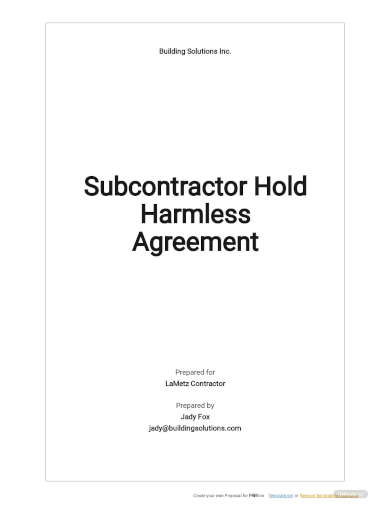
2. Sample Subcontractor Hold Harmless Agreement
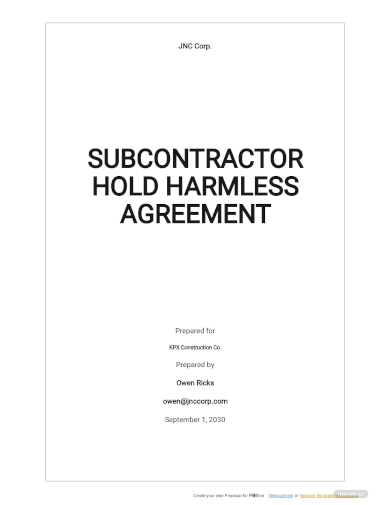
3. Standard Subcontractor Hold Harmless Agreement
4. Subcontractor Hold Harmless Insurance Agreement
5. Subcontractor Construction Hold Harmless Agreement
6. Editable Subcontractor Hold Harmless Agreement
What Is a Subcontractor Hold Harmless Agreement?
A subcontractor agreement is a contract that specifies the scope of work between a contractor or project manager and a subcontractor in the construction industry. This demonstrates that all parties reached an amicable agreement and that the assignment will be successfully completed. Subcontractors should thoroughly review the subcontractor agreement and ensure that all obligations are met to avoid putting themselves in unnecessary danger. The duration of the project, the scope of work, communication channels, and even payment terms are all detailed in a number of subcontractor agreements. Some contracts use terms like “pay when paid” or “pay if paid” to specify when a subcontractor is rewarded and when they are not. Other subcontractor agreements, on the other hand, are more equitable in their treatment of both contractors and subcontractors. Depending on the terms of the agreement, subcontractor agreements may be more advantageous to subcontractors than traditional verbal agreements in some cases. If a government agency signs a contract with a large corporation, the large corporation may be held liable for the upkeep of the government agency’s commercial property. The upkeep of each location could be contracted out to a subcontractor by a large corporation. As a result, the maintenance services are performed by the subcontractor, and the large corporation profits by charging the government department more for those services than the government department paid the subcontractor initially. Government subcontractors, individuals, businesses, and non-profit organizations are all eligible.
How To Write a Subcontractor Hold Harmless Agreement
While it may appear that a subcontractor agreement benefits contractors rather than subcontractors, the arrangement may actually benefit subcontractors. This is a formal written document that outlines the work to be done, as well as the expected completion date and other important factors to consider throughout the construction process, as the name suggests. Subcontractors can protect themselves by demonstrating what the contractor or owner was supposed to do if they have all relevant information and figures. Subcontractors can avoid some of the more onerous provisions in their subcontractor agreements by carefully reviewing the clauses and refusing to take unnecessary risks. Subcontractors can use the subcontractor agreement to exercise their rights and, among other things, improve the operations of their own businesses. A subcontractor agreement should contain a number of important clauses that must be adhered to. A few key points should also be understood by subcontractors. The variables listed below have the potential to positively or negatively influence the agreement.
- Scope of work
Make sure the scope of work is clearly defined in the agreement you sign when hiring a subcontractor. A subcontractor’s scope of work is a list of the tasks that must be completed. It can be difficult to come to an agreement on a wide range of projects, and subcontractors may fail to meet deadlines. It’s easy to assume that a subcontractor didn’t finish the project’s work if a task isn’t written down completely. As a result, having a clearly defined set of responsibilities is essential. - Supply chain
The amount of risk in the supply chain and other operational issues are also factors to consider when signing a subcontractor agreement. The subcontractor does not always have complete control over the owner’s supply chain or commodities. The subcontractor should not be held liable for the actions of the owner in these situations. On the other hand, some contracts are designed to shift risk to subcontractors. It can be as simple as quickly reading and agreeing to the subcontractor agreement to manage supply chain risk. - Defense and indemnification
They frequently use the terms “defense,” “insurance,” and “subcontractor agreements,” and they do so frequently. If you’re working on a project with a contractor, you’ll almost certainly have a defense and indemnity clause. On the other hand, these criteria can sometimes overburden the subcontractor. Some states have passed legislation to protect subcontractors from contract documents that include unfair indemnity clauses. Other states have also enacted legislation to ensure that they do not pay out excessive sums of money. Subcontractor agreements between subcontractors should include defense and indemnification clauses. - Insurance, Bonds, Liens
Clauses relating to subcontractor insurance, liens, and bonds, among other things, may be included in contracts with subcontractors. The job’s insurance and bonding requirements should be communicated to all subcontractors. The subcontractor agreement, on the other hand, may state that the subcontractor is not allowed to file a lien. If subcontractors aren’t paid on time or at all, they can’t file a mechanic’s lien. - Warranty
A subcontractor agreement’s work guarantee may vary from project to project, but this is project-specific. Both the contractor and the subcontractor benefit from this contract clause. If a subcontractor’s work is good and well documented, his or her reputation will be good. If something goes wrong due to an accident, the subcontractor can handle it while maintaining their good reputation. - Arbitration
Subcontractor agreements frequently include arbitration clauses. Subcontractors do not receive the same treatment as employees. Rather than going to court, any claims must be resolved through binding arbitration. As a result, subcontractors will be unable to seek legal redress for contract-related issues. A subcontractor might or might not be a problem for your business, but it’s something to think about when hiring one. - Conditional Payment
Contractual terms requiring payment only if work is completed are becoming more common in subcontractor agreements. To ensure that you pay before making a payment, use the phrases Pay if you pay and Pay when paid. As a result, subcontractors may not be paid on time or at all. Before subcontractors sign their contracts, this clause must be made clear to them. They risk losing their jobs if they don’t.
FAQs
Does a subcontractor have to give notice?
If you are hiring someone else to do electrical work or build a fence, you must follow the main contractor’s instructions. Two weeks’ notice is the norm.
Who is responsible for a contractor?
Payment only after the work is completed is becoming more common in subcontractor agreements. “Pay if paid” and “Pay when paid” are phrases used by people who make payment arrangements that are contingent on receiving payment. As a result, subcontractors may not be compensated for their work for a long time, if at all. Before signing contracts, it is critical that subcontractors understand this clause. They risk losing their jobs if they don’t.
What are contract documents?
The tender and acceptance process is comprised of numerous documents. Tender documents include designs and drawings, specifications, a schedule of quantities and rates, a letter of acceptance, and any agreed-upon changes.
The terms “employee” and “subcontractor” are not interchangeable. Individuals who work for themselves rather than for the contractor are known as subcontractors. They work on their own and make decisions about how to complete their tasks. It can be difficult to tell the difference between an employee and a subcontractor. If the subcontractor is an employee, the contractor’s responsibilities change (such as payment of superannuation contributions). The legal rights and responsibilities of a subcontractor differ from those of an employee.
Related Posts
Sample Business Agreement between Two Parties
FREE 9+ Shop Rental Agreement Samples [ Commercial, Lease, Tenancy ]
FREE 10+ Charter Agreement Samples In MS Word | Google Docs | Apple Pages | PDF
FREE 10+ Mentoring Agreement Samples In MS Word | Apple Pages | PDF
FREE 10+ Partner Agreement Samples In MS Word | Google Docs | Apple Pages | PDF
FREE 10+ Individual Agreement Samples In MS Word | Google Docs | Apple Pages | PDF
FREE 10+ Strategic Agreement Samples In MS Word | Google Docs | Apple Pages | PDF
FREE 10+ Equity Agreement Samples In MS Word | Google Docs | Apple Pages | PDF
FREE 10+ Producer Agreement Samples in MS Word | Apple Pages | PDF
FREE 10+ Grant Agreement Samples In MS Word | Apple Pages | PDF
FREE 8+ Meeting Agreement Samples in MS Word | Google Docs | Apple Pages | PDF
FREE 10+ Community Agreement Samples In MS Word | Google Docs | PDF
FREE 8+ Real Estate Option Agreement Samples in MS Word | PDF
FREE 10+ Call Option Agreement Samples In MS Word | PDF
FREE 10+ Advertising Agreement Samples In MS Word | Google Docs | Apple Pages | PDF

